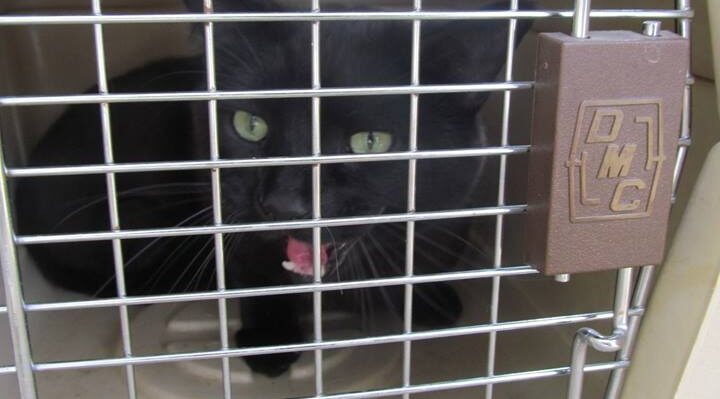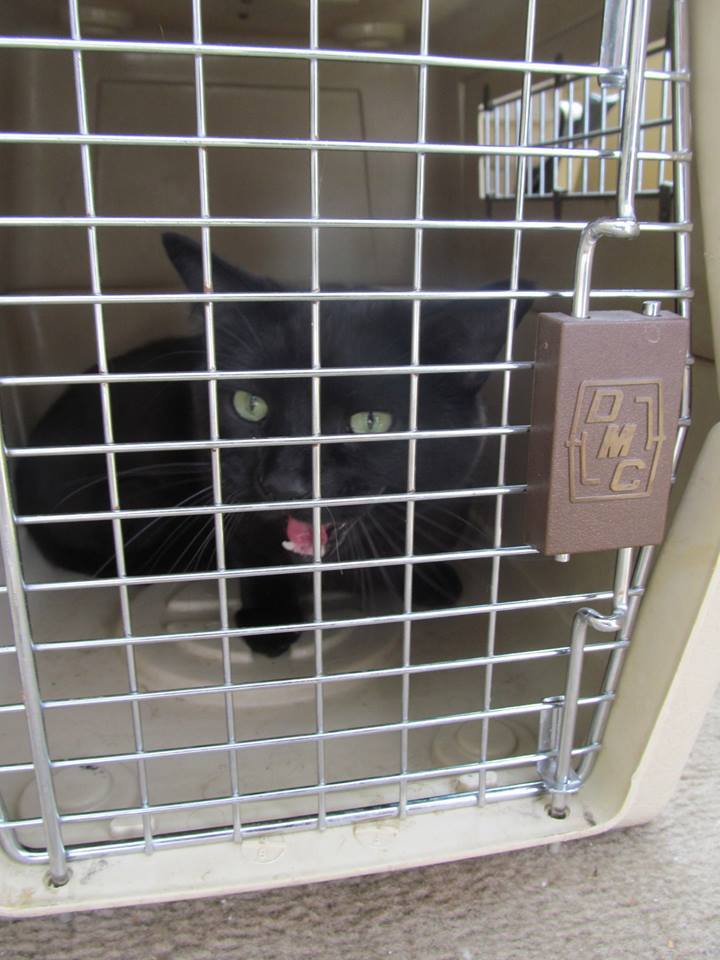

Last week, I was asked a question that I needed help to answer. A local friend had gotten an emergency evacuation order from the power company for a gas leak in the apartment complex.
I posted the message I’d received and asked cat guardians online for their advice.
My friend wrote: “Have you done an article on best cat carriers? Franny can unzip the fabric ones. We had a gas leak scare yesterday and I attempted to gather up the cats to get them out. I put Franny in a pillowcase, and she immediately clawed a hole in it and escaped. I’m thankful that Avista gave us the all-clear because I was unable to safely gather them up.”
I asked cat guardians about escape-proof cat carriers:
“Possible emergencies that involve evacuations, like gas leaks, fires, and floods, not to mention sudden trips to the vet for immediate health care, all might involve what should be safe (and as comfortable as possible) transport for your cat or cats. You’re going to need an escape-proof carrier! What would you recommend?”
Here are some of their suggestions:
Harve Morgan (California) Most folks wait until the need arises to bring out the carrier. Start your pet out by acquainting it with the carrier. Leave the carrier out so they see it as normal. Don’t wait until it is a necessity. During the 2003 fires in San Bernardino, many dogs and cats had to be tranquilized during evacuations because they had never been in a kennel or carrier. Those that had been before were relaxed and made it through.
Jill Gibbs (Montana) Hard-sided crate would be the best option, in my opinion. If a soft crate is preferred, get one with a clip at the top where the zipper stops.
Teri Stripes (Washington) Ditto. Our zippers clip together on our soft-sided carriers, which is likely why our cats have not escaped. But there are six zippers and I fear forgetting to clip one or two.
Cats, like dogs, can get out of many carriers if they try hard enough. That said, also like dogs, if you raise cats right or condition them to not hating a crate or cage/containment, they will be very good. We currently have soft-sided carriers with no-scratch webbing. The two boys dislike them a great deal. So the next time we use them I will also have a lead on the boys just in case of an escape. If any carrier is foolproof for a cat, it would be the old school VariKennel airline crates.
Micha Michlewicz (Maryland) Hard-sided crates are best. It’s ideal to condition the cat to a carrier before you ever need to use it. Pairing great things to the carrier and leaving it open will organically condition the crate to be a secure, pleasant place. When a cat is comfortable, the crate options open up and soft sided ones can be considered safely.
Frances Dauster (Alabama) OMG. Reminds me of when I immigrated to the USA. My cat shredded the carrier at 30,000 feet and went bonkers on the meds the vet had me give him “to sedate him”—HA HA, the joke was on me. Nine hours and 45 minutes of screaming Siamese in business class. My three kids, 7, 7, and 6, were easy. The cat? Not so much. It was a reinforced Lufthansa carrier. We ended up clam-shelling Bumble (Bumble Bee was his name) into two food-service trays duct-taped together with biohazard tape … OMG!
Sandee Strobel Szabo (Virginia) Pillowcase. This is how a vet recommended that we transport our cat to them. He recommended putting the cat in a cotton pillowcase and placing our cat, in the pillow case, on our lap near our stomach to hear and feel our breaths and heartbeat.
Jenny Beard Biehunko (Alabama) I love the Sleepypods. Use the bottom part as a regular daily cat bed for your kitty and simply zip the top on when you’re ready to go. That way, it feels and smells like “home.”
Stephanie Presdee (United Kingdom) When we ran a cattery, our advice was to get your cat used to the carrier box and spray bedding with Feliway or some such relaxant. Bring their bedding and usual bowls, and because we were in Spain and there were so many diet choices of cat food, we charged less and said bring their usual food. One from Saudi had raw fish … that I had to gut fresh every day. Let them use the crate as a bed at home; catnip helps. Never rely on the clips; always use a little padlock or extra ties. When we picked up cats from the clients in the car park, we always carried the front wire/mesh area towards us. We had double-gated catteries, so were safe.
6 Best Cat Carriers for Nervous Cats excitedcats.com
Important features to consider when buying a cat carrier for your nervous cat
The number of doors. While some placid cats are easy to get in the small side doors seen on most cat carriers, you might find that’s not the case with a nervous cat! Top doors offer a great alternative as they’re usually larger. It’s also much easier to place your cat directly into a carrier from the top, rather than trying to squeeze them into a small door from the side.
Internal leash. This is something we like to see on carriers designed specifically for nervous cats. If your cat’s flight response kicks in while they’re being transported, it can be a big worry that they make a bid for freedom as soon as you open the door. If you select a cat carrier with an internal leash, you can clip it onto your cat’s harness. That way, when you open the door, you know that they’re still secured safely to the leash and you can unclip them. Of course, we recommend making sure that your cat is fully trained to wear a harness before you attempt this, and you should only ever carry out shorter trips, where your cat is fully monitored.
Ventilation. While all cat carriers must be fully ventilated, some nervous cats like to be able to see out as much as possible. If that sounds like your cat, then something like a soft-sided carrier with plenty of mesh panels will suit them well. On the other hand, some nervous cats prefer an area where they can “hide,” in which case a hard carrier with a section that doesn’t have any ventilation holes in that spot is a good idea.
Airline approved. If you want to travel on a plane with your nervous cat, then make sure you select a cat carrier that has been approved for use with major airlines. These are usually slightly smaller, with dimensions to suit the size of cabin baggage.
8 Best Cat Carriers for Large Cats in 2023 excitedcats.com
What’s the difference between hard and soft carriers?
Hard cat carriers are made from rigid plastic and have wire mesh or plastic doors. They’ve very robust and generally accepted to be the safest way to transport your cat because it’s much less likely that they can escape. They’re heavy, though, and are sometimes too big to be accepted as an airline carry-on.
Soft carriers look similar to a hold-all bag but have mesh sections for ventilation and so your cat can see out. Many soft carriers are approved for airline carry-on and can also be safely secured to the seats of airplanes and cars. The soft mesh sides are not always robust enough to stand up to a determined cat’s scratching and chewing, though.
Backpack carriers are another option—which allows you to carry your cat on your back. These often have a rigid front section with a softer fabric back. They’re great for short trips or even if you want to take your cat for a walk, but they’re usually not big enough to allow your large cat to lie down.
Should I buy a hard or soft carrier?
This depends on your personal preference as well as that of your cat!
While hard carriers are more secure, they’re difficult to store when not in use and can’t be taken onboard planes. Some cats prefer the security of being within a hard carrier when traveling.
Soft carriers are excellent for airplane trips, as many of them are approved for use in the cabin of the plane. They’re easy to travel with and fold flat for storage when not in use.
Ultimately, it’s best to try both if possible! You might be able to borrow one of each from a friend before investing in one yourself. We like to use each of these types of carriers for different purposes (and cats!) so have a couple of each both hard and soft.
The Best Cat Carriers for 2023 Cats.com
Making It Fun: How To Help Your Cat Get Used To The Cat Carrier
Instead of cajoling or manhandling your cat into the carrier when it’s time to go to the vet or on a trip, why not help them to enjoy it? Here are a few ways to make carrier time more fun.
Introduce It as A Bed
Leave the carrier in a well-loved part of your house, place familiar blankets or a pillow inside of it, and let your cat use it as a bed or hideout. By the day of the trip, your cat should be familiar with the carrier and think of it as a comforting extension of their home.
While some carriers are collapsible and easy to slide onto the top shelf of a closet when not in use, I don’t recommend this practice for several reasons.
If a carrier remains folded and shelved most days of the year, your cat will never get to know it outside of stressful situations. If they never see it until five minutes before they’re toted into the car, your cat will inevitably associate the carrier with that stressful event.
Secondly, having a cat carrier at the ready is an important aspect of emergency preparedness. If you need to evacuate your home suddenly, you should be able to pop your cat in their carrier and go.
Give It A Familiar Scent
As mentioned in the previous tip, familiar scents will help your cat soften toward the new carrier. By placing well-loved blankets, towels, a cat bed, or even your own clothes inside the carrier, you tell your cat “this is yours.”
Use A Pheromone Spray
If all goes well, your cat will eventually mark the carrier with their own facial pheromones. In the meantime, you can use a synthetic pheromone spray to soothe your cat and identify the carrier as a safe place to be.
Cats in Carriers: What’s Going Through Your Cat’s Head? PetMD.com
How to Get Your Cat Used to the Carrier
First, provide your cat with a very gradual introduction to both the carrier and the experience of being transported within the carrier. Incorporate his natural instinct to feel safe and secure by adding soft, familiar bedding in his carrier. Cats regard a small cozy space as safe, almost like a cocoon or sleeping bag. We see it all the time when they play and hide in bags or boxes. Any carrier you use should provide that same feeling of security.
Another important tip is to make your cat’s carrier part of your home’s normal “furniture” so it smells familiar to your cat. This helps make the carrier not as scary and eliminate its association with negative experiences. If it isn’t possible to move the carrier into your cat’s normal living areas, place the carrier out in your home at least 24 hours before you plan on transporting your cat. A cat’s sense of smell far exceeds humans. To your cat, there is a world of difference between the smells in the living room and the smells in your garage or basement.
Finally, one of my favorite tips is to serve your cat his favorite cat treats, food, or catnip in the carrier. He will likely love it immediately. Simply placing your cat’s favorite toys in the carrier and leaving the door off can all make it much more cat-friendly in your cat’s mind. Once he is comfortable inside the carrier, you can try moving its location by a few inches. If your cat tolerates the move, then try moving it a few feet, or even placing the carrier up on a chair to work with your cat’s desire to have a “vertical advantage.” Once your cat is totally comfortable with the carrier, you could even take him outside in it. This simulates what will happen when you take your cat on his annual or semiannual trip to the veterinary clinic to keep him healthy.
So, in summary:
1. Start carrier training when your cat is young.
2. Integrate the carrier into your home as much as possible, ideally creating a normal resting spot.
3. Place treats, toys, and catnip in the carrier.
4. Place familiar bedding or a towel in the carrier.
5. Be patient. If your cat senses that the carrier is unusual, he or she will act accordingly!
Reducing Cat Stress During Car Rides PetHealthNetwork.com
Cat Backpacks welovecatsandkittens.com

Photo by Val Hughes
My family travelled with our cats when I was a kid—including road trips with overnight stays in motels. Their carrier was typical for the 1950s and 1960s, a sturdy box of a hard cardboard material, with a handle and air holes in the top. Not exactly “safe” according to today’s standards, but it worked fine for the cats and for our family. (We were never in an accident.)
I have used a #100 VariKennel, the smallest size, since I first bought #400 VariKennels for my dogs. The #100 can be strapped in with a seat belt through its handle and it can ride in a passenger seat. It can be set with the door upright and open, often making it easier to drop a cat in gently, avoiding the usual wrestling when you try to shove them in and get the door closed when the crate is on its bottom. I trust the safety of dogs in VariKennels and I trust the safety of a cat, too.



